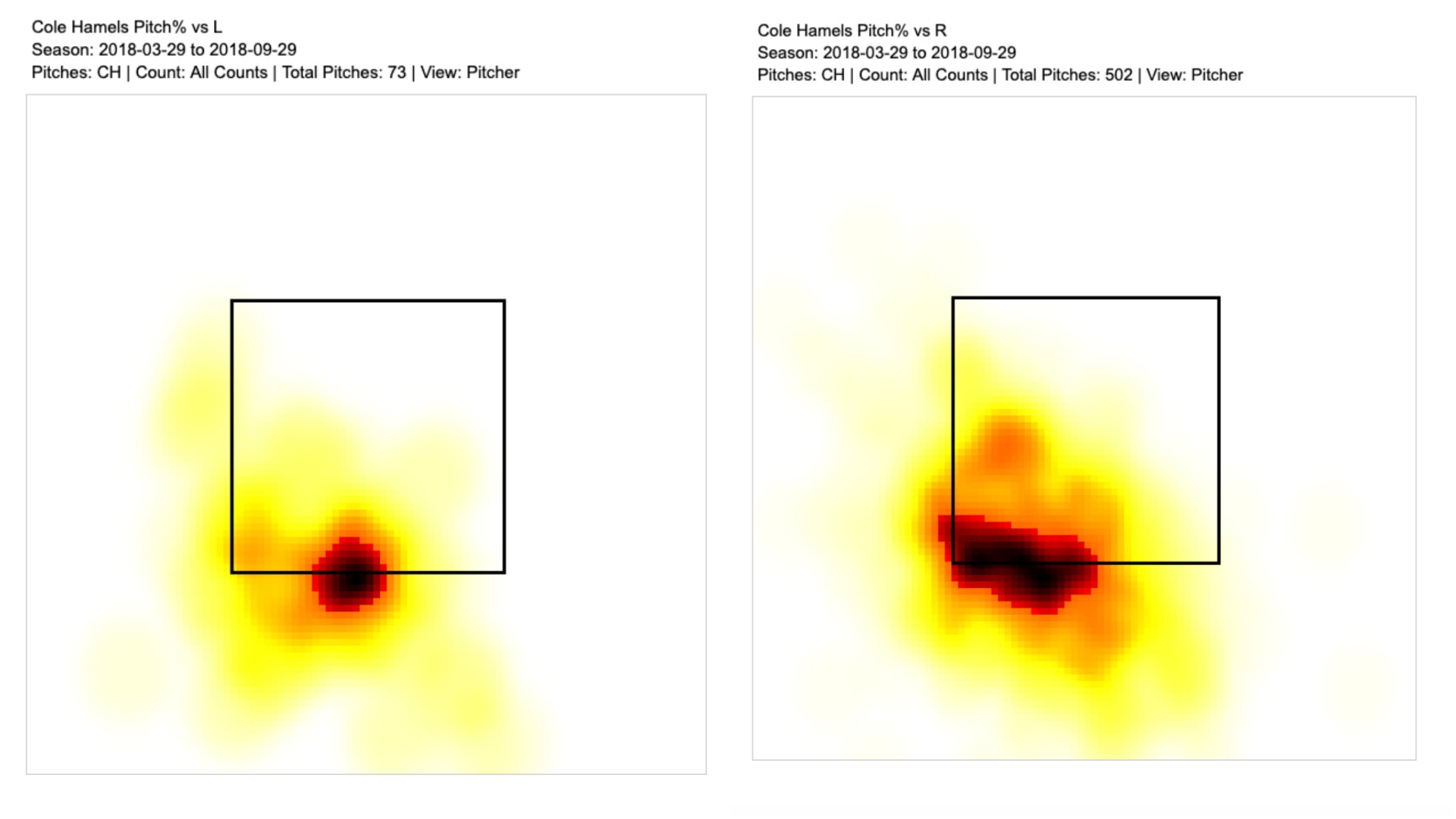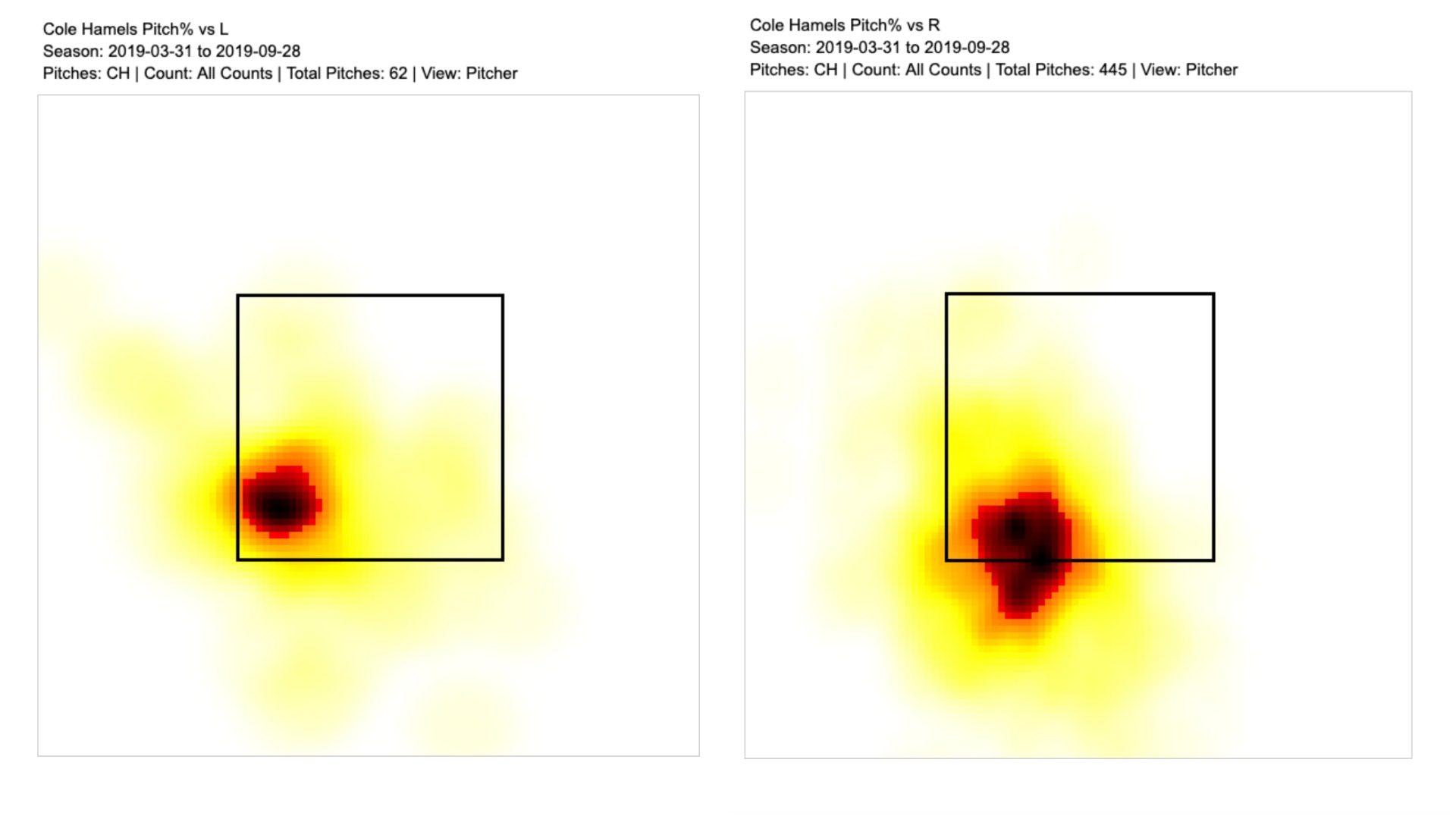Cole Hamels’ Vintage Changeup Returned in 2019
There’s a lot of starting pitching on the free agent market this offseason. There’s Gerrit Cole, Stephen Strasburg, Madison Bumgarner, Zack Wheeler, Dallas Keuchel, and Hyun-Jin Ryu, among many others. But one guy who has always piqued my personal interest is left-hander Cole Hamels, who is entering free agency for the first time in his 14-year major league career.
Hamels ranked as the 19th-best free agent on the FanGraphs’ Top 50 released earlier this month. Kiley pegged him for a two-year, $28 million contract, and the median (two-years, $30 million) and average (1.93-years, $28.2 million) crowdsource values were pretty close to that. Per his agent, John Boggs, he’s already generated interest from 13 different teams; according to Boggs, Hamels plans to pitch “at least five more seasons.”
Whether or not Hamels can actually pitch for another five years remains to be seen, but what is certain is that he still had plenty left in the tank in 2019. Hamels pitched 141 and two-thirds innings this season, to the tune of a 3.81 ERA and a 4.09 FIP. He struck out 23% of hitters and walked just 9%. Hamels was worth 2.5 WAR over his 27 starts, a solid figure, especially for the middle-of-the-rotation starter Hamels is now. Shoulder and oblique injuries kept him from making a full season’s worth of starts, but when he was on the mound, he was solid.
Driving much of this success was Hamels’ changeup, which experienced a resurgence in 2019. Check out his weighted runs above-average on the pitch by year:
| Season | wCH |
|---|---|
| 2006 | 14.5 |
| 2007 | 17.4 |
| 2008 | 23.4 |
| 2009 | 11.8 |
| 2010 | 6.2 |
| 2011 | 29.3 |
| 2012 | 13.8 |
| 2013 | 28.6 |
| 2014 | 19.7 |
| 2015 | 17.2 |
| 2016 | 0.9 |
| 2017 | 7.0 |
| 2018 | 0.9 |
| 2019 | 11.6 |
Hamels’ +11.6 runs above-average on the changeup in 2019 was his highest single-season mark since 2015. His changeup was more valuable this season than it was in the last three seasons combined. Narrowing our focus a little bit, let’s take a look at the results on Hamels’ changeups from each of the last five seasons:
| Season | wOBA | wRC+ | K% | BB% |
|---|---|---|---|---|
| 2015 | .246 | 63 | 33.5% | 7.0% |
| 2016 | .331 | 118 | 24.0% | 7.8% |
| 2017 | .252 | 65 | 25.6% | 6.2% |
| 2018 | .277 | 82 | 32.4% | 6.1% |
| 2019 | .214 | 37 | 32.0% | 7.8% |
Hitters really struggled against the pitch this season. Collectively, they hit .159/.229/.254 and produced a 37 wRC+. Hamels hasn’t seen results that good against the changeup since 2013, when hitters posted a mere 28 wRC+ against it. For his career, 2019 represented Hamels’ third-lowest opponent wRC+ versus the pitch. Hamels has the best changeup of the past two decades, and somehow, it managed to get close to its pinnacle in 2019. That’s certainly good news for his free agency case.
The story doesn’t end there, though. Pitch values are not predictive, with a year-to-year correlation below 0.25. They tell you how good a pitch was in one particular season, but they have very little power to tell you how the pitch will perform the next year. We can see this very phenomenon within Hamels’ pitch values themselves — intrinsically, Hamels’ changeup was more or less the same pitch in both 2018 and 2019. It just so happened that the results were significantly better in 2019.
What is more likely to be sticky, however, are Hamels’ tendencies when throwing the pitch. These are statistics that are more within his control. For example, 32.4% of Hamels’ changeups in 2019 were in the strike zone, compared to 27.5% in 2018. While he cannot fully control whether each individual pitch ends up in the strike zone, trends like those are interesting because they demonstrate a level of intent. Did Hamels intend to throw more changeups in the strike zone this season? The answer appears to be yes.
Here are Hamels’ changeup heatmaps from 2018:

And here are Hamels’ changeup heatmaps from 2019:

Note that all four of these heatmaps are from the pitcher’s perspective, meaning that Hamels consistently attacked the inside part of the plate with the changeup to left-handed hitters and the outside part of the plate with the changeup to right-handed hitters. Regardless, it’s not hard to see that more of Hamels’ pitches were inside the strike zone in 2019 than they were in 2018.
If a pitcher starts throwing his pitches inside the strike zone more often, we might expect hitters to swing more, too. For Hamels, that is exactly what happened. Opposing hitters swung at 59.8% of Hamels’ changeups this season, a 2.4-point bump from 2018, when they swung at 57.4%. Though the hitters’ response is not statistically significant, Hamels’ increase in zone rate is. And perhaps most notably, Hamels’ groundball rate against the changeup experienced a huge spike — from 48.5% to 57.3%.
The idea here is that Hamels made a tangible change to his game by throwing the changeup in the strike zone more often. As a result, hitters swung at his pitches more regularly, and when they made contact, they tended to put the ball on the ground. In turn, that would seem to lead to worse results against the pitch, which is indeed what happened.
Where this logic falls short can be demonstrated through Hamels’ expected statistics. His xwOBA allowed with the changeup this season was .265, 51 points higher than his actual wOBA allowed of .214, and actually 10 points higher than his xwOBA allowed with the changeup in 2018.
On fly balls, Hamels was especially lucky, but the same size was so small (only 12 fly balls allowed) that it’s hard to call that anything more than random variation. Yes, we might expect worse results on balls hit in the air against Hamels’ changeup in 2020, but if he’s allowing so few fly balls to begin with, the difference in performance might not be extremely significant. Hamels also experienced some good fortune on groundballs, a fact that is likely more concerning since that tends to be the most common batted ball result off the pitch by far. Weirdly, among the 37 pitchers to allow at least 50 groundballs against the changeup this season, Hamels’ xwOBA against was the fifth-highest, even if the .232 mark still looks quite solid in a vacuum.
I broke this down further by looking at Hamels’ distributions of launch angles and exit velocities against the changeup for both 2018 and 2019. If anything, I found that Hamels actually improved in the exit velocity category. His average exit velocity on the changeup decreased just shy of one full mph, and his distribution appeared to get better, too:
| Exit Velocity (mph) | 2019% | 2018% |
|---|---|---|
| 31-40 | 2.2% | 0.9% |
| 41-50 | 0.0% | 0.9% |
| 51-60 | 5.4% | 4.6% |
| 61-70 | 6.5% | 7.3% |
| 71-80 | 25.0% | 21.1% |
| 81-90 | 23.9% | 28.4% |
| 91-100 | 27.2% | 22.0% |
| 101-110 | 7.6% | 13.8% |
| 111-120 | 2.2% | 0.9% |
In both 2018 and 2019, approximately 63% of Hamels’ batted balls against his changeup came off the bat at or below 90 mph. However, Hamels did see a year-over-year increase in the percentage of batted balls at or below 80 mph, a solid four-point jump from 35% to 39%.
The launch angles are where things get a bit weird. Hamels’ average launch angle versus the changeup increased from 5.9 degrees in 2018 to 6.8 degrees in 2019, even while the standard deviations (27.8 in 2018, 27.7 in 2019) remained relatively unchanged. Even more interesting are his median launch angles — 4.9 degrees in 2019 compared to 8.7 degrees in 2018. What this is ultimately saying is that in 2019, Hamels saw some very extreme launch angles that skewed his distribution to the right, all while he was allowing more groundballs (thus the lower median) in the process. In 2018, the roles were reversed, with Hamels’ average launch angle sitting a few degrees below his median, meaning that a few very low launch angles were driving the average down.
This may explain why Hamels’ expected stats demonstrate his relative luckiness in 2019 — there were quite a few batted balls off his changeup that were hit at high launch angles, those that are likely to go for extra-base hits. However, I still contend that the overarching theme remains true: Hamels specifically pitched his changeup in the strike zone more often and was rewarded with such fortunate results because hitters tended to roll them over. That may not continue in 2020, but if I were a team looking for starting pitching, seeing Hamels have this much success with his changeup would make me want to call his agent right away.
Devan Fink is a Contributor at FanGraphs. You can follow him on Twitter @DevanFink.
